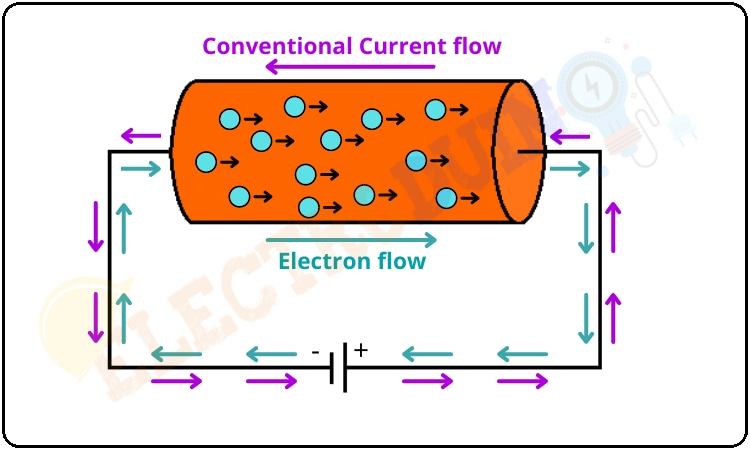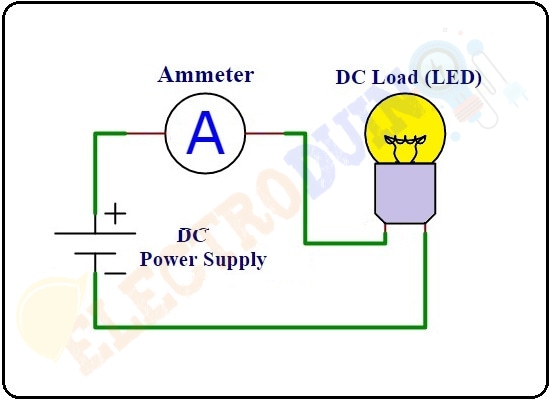What is Electric Current – its Unit, Symbol, Types, and measurement » ElectroDuino
Hello friends! Welcome back to ElectroDuino. In the previous tutorial, we have learned about Electric Charge. This blog is based on Electric Current. Here we will discuss what is Electric Current, Unit, Symbol, Types, Conventional Current flow, and how to measure current.
What is Electric Current?
Definition: Electric current is defined as the rate of electric charge flow through a conductor with respect to time. In other words, the rate of flow of electrons in a conductor with respect to time is called an electric current.

The conducting materials have a large number of free electrons, they are able to move from one atom to the other at random. Electrons are negatively charged particles of an atom. So, when Electrons are randomly moving in a conducting material, that why a number of charges also randomly moving in the conductor.

When a force (or EMF) acts on the electrons to move them in a particular direction, then all electrons will drift in the same direction, So there will an overall movement of charge in one direction.

Symbol and Unit of Electric Current
The symbol “I” is used to represent the Electric current. According to the definition of electric current, mathematically it can be expressed as the rate of electric charge flow with respect to time. It means

The Electric Charge is measured in coulombs (C) and time is measured in seconds (S). So the unit of electric current is coulomb/seconds (C/s) or Amperes (A). Ampere (A) is the SI unit of electric current.
1 ampere definition: A current of 1 ampere means that there is one coulomb of electric charge passing through a point of a conductor in one second.

Dimensions of Current
Dimensions formula of current is determined using mass (M), length (L), time (T), and ampere (A). The Electric Current (I) is a representation of the coulomb per second. Thus, the Dimensions formula of current is
M0L0T−1Q
Where, M = Mass, L = Length and T = Time, Q = Current
Electric Current is Scalar or Vector Quantity
The Electric current is a scalar quantity. When a physical quantity has both magnitude and direction, then this quantity is said a vector quantity. But not only these two factors determine that the quantity is a vector or scalar quantity. There are some other factors like, if the physical quantity obeys the vector addition laws such as triangle law of vector addition and parallelogram law of vector addition, then this quantity is said to be a vector quantity. In the case of electric current, when two or more currents meet at a point, the resultant current of these will be an algebraic sum, but not the vector sum. Therefore, despite the magnitude and direction of the electric current, it is a scalar quantity.
Types of Electric Current
Based on the direction of charge flow, the electric current is classified into two types. These are Alternating Current (AC) and Direct Current (DC).
Alternating Current (AC): In this type of current, the flow of electric charge changes its direction periodically. The Alternating Current or AC current can generate by an alternator. This type of electric power is widely used in industrial and residential applications.
Direct Current (DC): In this type of current the flow of electric charge in only one direction. Direct Current or DC are mainly generated by batteries, solar cells, fuel cells. Also, an alternating current can be converted to a direct current by using a rectifier circuit. Most of the electronic devices like, computers, TV, phones, satellites all are work on direct current.
Conventional Current flow Vs Electron Flow
The free electrons are the mobile charge carriers in the conductors, these are responsible for electric current flow through the conductors. When the potential difference is applied across the conductor some charged particles flow through the circuit which constitutes the electric current. The charged particles flow from higher potential to lower potential, which means the charged particles flow from the positive terminal to the negative terminal of the battery or cell through the external circuit.
The positive charge carriers and negative charge carriers flow in the opposite direction, but they have the same effect in the electric circuit. The current is flow due to either positive or negative charges, or both, a convention is required for the direction of the current that is independent of the types of charge carriers.
The direction of conventional current is considered to be the direction in which positive charge carriers flow, it means the conventional current flow from higher potential to lower potential. In other words, the conventional current flow from the positive terminal to the negative terminal of the battery or cell through the external circuit.
In contrast, Negative charge carriers (free electrons) flow in the opposite direction of conventional current flow, which means the free electrons flow from lower potential to higher potential. In other words, the electrons flow from the negative terminal to the positive terminal of the battery or cell through the external circuit.
The below figure shows the direction of the conventional current and electron flow in a circuit.

According to the above discussion, we can conclude that:
Conventional Current flow: The conventional current flow is from the positive to the negative terminal through the external circuit and it indicates the direction that positive charges would flow.
Electron flow: The electron flow is from negative to positive terminal through the external circuit. Electrons are negatively charged particles and are therefore attracted to the positive terminal as unlike charges attract.

How to measure current
The electric current measurement is an essential parameter in electrical and electronic circuits, it very important, we need to know what the value of current is flowing in a circuit.
An instrument that can measure the current is called an Ammeter. To measure current flow through a circuit, an ammeter must connect in series with the circuit.
For example, A LED (Light emitting Diode) is connected to a DC voltage source or battery. Now we need to the measurement of current through the LED by using an ammeter. The ammeter is connected in series with the LED, as shown in the below figure
















![Toni Kroos là ai? [ sự thật về tiểu sử đầy đủ Toni Kroos ]](https://evbn.org/wp-content/uploads/New-Project-6635-1671934592.jpg)


